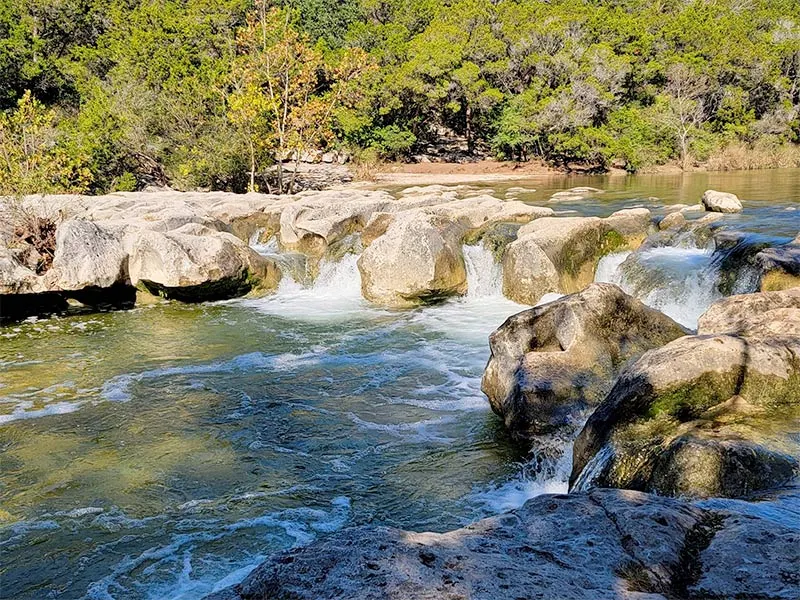
Nestled within the lush landscape of Austin, Texas, Twin Falls is a serene and picturesque retreat for nature lovers, adventure seekers, and anyone looking to escape the hustle of city life. Located in the heart of the Barton Creek Greenbelt, this scenic waterfall is not only a popular destination for locals but also a hidden gem for tourists who seek an authentic connection with nature. In this comprehensive article, we’ll explore the history, geography, activities, and tips for visiting Twin Falls, ensuring you have all the information you need to plan your trip.
1. Overview of Twin Falls
Location and Accessibility
Twin Falls is part of the Barton Creek Greenbelt, a vast network of trails, creeks, and natural features in Austin. The Greenbelt itself spans over 7.9 miles, offering numerous access points for visitors. Twin Falls is easily accessible from the trailhead located at 3918 S. MoPac Expy, making it a favorite spot for hikers and families.
The falls are a short hike from the trailhead, roughly 0.5 miles, making it an ideal destination for those looking for a quick yet rewarding nature escape. Its proximity to downtown Austin, just about 15 minutes away, makes it incredibly convenient.
Natural Beauty
The hallmark of Twin Falls is its cascading waterfalls that pour into a crystal-clear pool surrounded by limestone rock formations and verdant foliage. During periods of heavy rainfall, the falls are particularly vibrant, offering a dramatic display of nature’s power. Even in drier seasons, the area remains a tranquil oasis, with the creek providing a gentle flow of water.
The lush environment is home to various native plants and animals, creating a rich biodiversity that enhances the experience of visiting the falls. It’s a perfect spot for photography, meditation, or simply soaking in the natural beauty.
2. Historical and Ecological Significance
Historical Background
The Barton Creek Greenbelt, including Twin Falls, holds significant cultural and historical value for the Austin area. For centuries, the land was home to indigenous peoples who used the creek for sustenance and ceremonial purposes. The area later became a vital resource for settlers, providing water and a means for farming.
In the modern era, the Greenbelt was preserved through community efforts to protect Austin’s natural spaces amidst rapid urbanization. Today, Twin Falls serves as both a recreational hub and a reminder of the city’s commitment to maintaining its natural heritage.
Ecological Importance
Twin Falls plays an essential role in the local ecosystem. The creek supports a variety of aquatic life, including fish, frogs, and freshwater invertebrates. The surrounding vegetation provides habitat for birds, insects, and small mammals, making it a thriving ecosystem.
Additionally, the limestone formations around Twin Falls contribute to Austin’s karst topography, which helps recharge the Edwards Aquifer, a vital water source for the region. Visitors are encouraged to respect this delicate environment by adhering to Leave No Trace principles.
3. Activities at Twin Falls
Hiking
One of the primary activities at Twin Falls is hiking. The trail leading to the falls is part of the Barton Creek Greenbelt Trail, which is moderately challenging and suitable for hikers of all experience levels. The path meanders through dense woods, offering shaded spots and scenic views along the way.
For those seeking more adventure, the trail continues beyond Twin Falls, leading to other popular spots like Sculpture Falls and Campbell’s Hole. Each destination offers its unique charm, making the hike a diverse and rewarding experience.
Swimming
Twin Falls is a popular swimming spot, especially during the warm months. The pool at the base of the falls is shallow and inviting, making it a great place for families to cool off. The water is typically clear, providing a refreshing respite from the Texas heat.
Visitors should note that water levels can fluctuate depending on rainfall. During dry periods, the creek may have reduced flow, but the area remains a beautiful spot for relaxation and exploration.
Picnicking
The serene environment around Twin Falls makes it an excellent location for a picnic. There are no designated picnic areas, but visitors often find spots along the creek or under the shade of trees to enjoy their meals. Bringing a blanket and some snacks is a perfect way to immerse yourself in the natural surroundings.
Photography and Wildlife Observation
Nature photographers will find plenty of inspiration at Twin Falls. The interplay of sunlight on the water, the textures of limestone rocks, and the vibrant greenery create stunning compositions. Wildlife enthusiasts can also spot various species of birds, butterflies, and other creatures that inhabit the area.
4. Tips for Visiting Twin Falls
Best Times to Visit
The best time to visit Twin Falls is during spring and early summer when rainfall is more frequent, ensuring the waterfalls are at their most impressive. Early mornings and weekdays are ideal for those seeking a quieter experience, as weekends can be crowded.
What to Bring
- Water and Snacks: Stay hydrated and bring light snacks for energy.
- Proper Footwear: Hiking shoes or sturdy sandals are recommended due to rocky terrain.
- Sunscreen and Hat: Protect yourself from the Texas sun.
- Swimsuit and Towel: If you plan to swim, these are a must.
- Trash Bag: Help keep the area clean by packing out what you pack in.
Safety Tips
- Check Water Levels: High water levels after heavy rain can make swimming dangerous.
- Watch for Wildlife: Be aware of snakes and other wildlife common in the area.
- Stay on Trails: To preserve the ecosystem and ensure safety, stick to marked trails.
Parking and Fees
The trailhead parking lot can fill up quickly, especially on weekends. Arrive early to secure a spot. There is no entrance fee to visit Twin Falls, but donations to local conservation organizations are encouraged.
5. Nearby Attractions
Sculpture Falls
Just a short hike from Twin Falls, Sculpture Falls is another beautiful spot along the Barton Creek Greenbelt. Its cascading waters and deeper swimming holes make it a favorite among adventurous visitors.
Zilker Park
Located nearby, Zilker Park offers additional recreational opportunities, including kayaking on Lady Bird Lake, exploring the Zilker Botanical Garden, or enjoying the Austin Nature & Science Center.
Downtown Austin
After a day at Twin Falls, head downtown to experience Austin’s vibrant culture, music, and dining scene. Popular spots like South Congress Avenue and Rainey Street are just a short drive away.
6. Preserving Twin Falls for Future Generations
As more people discover the beauty of Twin Falls, it’s crucial to protect this natural treasure. Visitors play a vital role in conservation by following rules, respecting wildlife, and minimizing their impact. Community initiatives, such as cleanup drives and educational programs, are essential in ensuring Twin Falls remains a haven for nature lovers.
7. Conclusion
Twin Falls in Austin is a testament to the city’s natural beauty and commitment to outdoor recreation. Whether you’re hiking, swimming, or simply enjoying the serene surroundings, this destination offers a memorable experience for all. With proper planning and respect for the environment, Twin Falls can be a source of inspiration and relaxation for generations to come. So pack your gear, lace up your hiking shoes, and discover the magic of Twin Falls.

